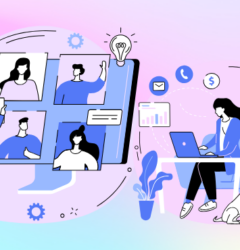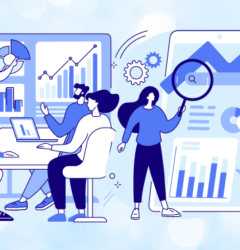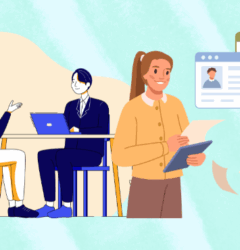
Reading Time: 8 minutes
This article was first posted on Customer Think.
Due to tech advancements, the consumer journey has changed a lot. The customers are already expecting too much because, through the internet, they want a personalised touch to their experience. 52% expect to use ChatGPT to answer customer questions, and 43% to outreach potential customers. In order to keep customers and expand the business, these needs should be met.
OpenAI chatbot, known as ChatGPT, is an advanced manner for developing your own trained AI models. The companies have improved the way they deal with customers and provide more personalized ways by using customer support with ChatGPT, that are efficient in using and understanding human-like languages.
Understanding Customer Support with ChatGPT
The GPT technology represents a major advancement in the natural language processing branch of AI. GPT is a learning model that generates human-like text and largely focusess on AI interactions and lies as a base for several applications.
GPT has a very noticeable quality of creating text that fits well within context and makes sense. The model has the ability to comprehend larger contexts and generate pertinent responses. This sets it apart from simpler models that only process immediate input statements. This is specifically seen in ChatGPT because the way it holds conversation feels similar to a human and resonates the same impact.
Also Read : What is Business Process Optimization? Proven Techniques & Insights
Adaptability and Learning
The GPT technology is also widely known for its adaptability across various platforms and applications. The model keeps updating new information to increase its learning cabinet. In order to keep updated with the language trends and users needs, GPT learnings should be continuous.
Implications for Conversational AI
The conversational AI methods are upgraded by the introduction of GPT technology, which is termed as ChatGPT. Businesses are facilitated to comprehend and deal with consumer questions and issues using a unique accurate method. this leads to high-quality customer service where the AI enables a quick interaction within different sectors (medical, education), hence building a good user experience.
Implementing ChatGPT for Customer Support
By integrating ChatGPT in the existing customer service department, we can take significant steps to enable smart and efficient communication with our clients. This process entails several key aspects:
Workflow Alignment
In any organization, customer services through ChatGPT must be organized efficiently and provide value to the company workflows. To introduce ChatGPT into your workflow without interfering with any existing operations, it is important to understand the workflow and identify key opportunities where a language model such as ChatGPT can add value.
Technical Integration
In order to integrate ChatGPT in an existing system, the machine learning model used in it and other support tools need to be compatible with each other. It is necessary for ChatGPT to have an interface through which it can access the requested information from tech domain.
User Interface Design
The ChatGPT should be a user-friendly and interactive platform for customers. It is neccessary that the layout should allow communication that is easy to make and impactful whether through the website, mobile phone or a social platform.
Monitoring and Evaluation
Observing the performance of ChatGPT on a regular basis is pivotal to check if it’s meeting the required benchmarks. These regular evaluations will help us improve the quality and standards of the system.
Training ChatGPT to Understand Customer Queries
In order to provide maximum benefit of ChatGPT in customer support services, it must be taught in a way that it can grasp and answer specific jargons of the industry. This involves:
Data Collection
The first step to guide ChatGPT is to collect important details such as typical questions customers ask, specific words of industry, and general incidents.
Customization and Fine-tuning
By customizing the dataset, the ChatGPT can be optimized to deliver specific interindustry requirements. The process includes a phase where models are trained to recognize how customers phrase their questions and the industry norms.
Real-world Interaction Training
The training for ChatGPT is not only done at the start-up. it should be smart enough to grasp the things from real world interactions, needs of customers, and industry related language changes.
Feedback Mechanisms
Integrating feedback during customer conversations can improve the ChatGPT responses as it provides a way to correct inaccuracies and provide human-like responses.
Ensuring Data Privacy and Security in ChatGPT
Integrating ChatGPT into customer service also involves addressing issues regarding privacy and security:
Compliance with Regulations
Observing the General Data Protection Regulation (GDPR) within the EU and California Consumer Privacy Act (CCPA) in the US is vital. This encompasses understanding and following all legal requirements for customer information
Data Security Measures
It is necessary to take strong measures that protect client information. These include secure data storage, encryption of data when it is being transferred, as well as regular security audits to identify and fix any weak areas.
Transparency and Consent
Through being open about how individuals’ information is being utilized and seeking their agreement, companies can legally satisfy several provisions. Expressing clearly what ChatGPT does together with the measures taken to maintain confidentiality would contribute towards developing customer confidence.
Regular Updates and Assessments
Consistent updating of security protocols, assessment of compliance with privacy laws guarantees uninterrupted protection of consumers’ data, while remaining aligned with lawful requirements.
Dealing With High Inquiry Volume
If we’re discussing customer service, then scalability is one of the most important aspects:
Managing Peak Times
When there are high volumes of inquiries, ChatGPT can handle the extra workload without the need to staff up. This ensures that whether you’re half busy or swamped, customers will always get consistent service that doesn’t make them feel like they’ve been put on hold for an eternity.
Scalability and Flexibility
The flexibility that ChatGPT offers makes it perfect for brands with fluctuating inboxes. It doesn’t matter if the team has to deal with 30 tickets a day or 3,000. The technology adjusts accordingly and keeps response times in check.
Reduced Queue Times
With ChatGPT taking care of a bulk of queries, customers don’t have to wait as long to get their answers. Even at peak times, expect faster resolution times.
Better Overall Experience
With ChatGPT taking care of a bulk of queries, customers don’t have to wait as long to get their answers. Even at peak times, expect faster resolution times.
Better Overall Experience
By handling large amounts of requests smoothly, ChatGPT improves overall customer experience by delivering quick and accurate responses.
Making Customer Interactions Personal with ChatGPT
The personalizing ability of ChatGPT in conversational experiences is a key aspect that draws customers to it for support. This personalization is done through various ways:
Individual Preferences Understanding
By reviewing previous conversations and customer-supplied information, ChatGPT can understand people’s individual preferences and requirements. In so doing, more personalized conversations take place which resonate with the specific context of the client.
Contextual Awareness
Apart from data analysis, ChatGPT is good at maintaining context while talking. Thus, it can refer to what was said earlier in order to have a more consistent conversation that makes sense with reference to the subject matter being discussed.
Adaptive Response Generation
Considering the customer’s style and preferences, ChatGPT can change its tone, language and contents. Therefore, all customers feel like they are talking in whatever way that suits them best.
Real-time Learning
The dialogue becomes more natural as ChatGPT interacts with a client because it learns from each other hence turning it into an increasingly personalized conversation.
Tailoring Responses Based on Customer History
The ability of ChatGPT to tailor responses based on customer history significantly enhances the quality of customer service:
Accessing Interaction History
Through CRM systems integration, ChatGPT can access the past information about customer interactions. In return, the platform which is able to keep track of previous customers’ enquires including preferences, and problem faced during their association with the company.
Continuity in Service
In this way, ChatGPT ensures that there is continuity in customer service. As a result, they are not forced to give again the same data as AI is already cognizant of their previous chats and will pick it up from where they left off last time.
Customized Solutions
Unlike other models which offer generic solutions, ChatGPT can come up with a solution based on interactions made before.
Improving Customer Satisfaction Through Recommendations
ChatGPT can significantly enhance customer satisfaction and drive sales through personalized recommendations.
Data-Driven Recommendations
With the help of purchase history and customer preferences based on data analysis by ChatGPT it can recommend products that may interest customers.
Dynamic Interaction
During a conversation, ChatGPT might respond to certain things or expressed requirements by suggesting the products or services that align with such needs thereby making these recommendations more timely and relevant.
Cross-Selling and Upselling
Additionally, it identifies opportunities for cross-selling and upselling where additional products or upgrades can be suggested that complement what a customer has bought or indicated interest in.
Building Customer Loyalty
These personalized interactions and relevant recommendations from ChatGPT help in building long-term customer loyalty besides enhancing immediate customer experience.
Automating Customer Service with ChatGPT
The integration of ChatGPT in customer service primarily enhances efficiency and reduces response times:
Instant Responses
Quick replies from Chat GPT reduce waiting time for customers since this AI responds to inquiries immediately critical to maintaining high levels of satisfaction among customers. According to a study, 85% of consumers prefer to message brands
Efficiency in Handling Inquiries
ChatGPT automates the response to routine inquiries, allowing customer service teams to operate more effectively. This way, human agents do not need to spend much time dealing with simple and common requests since they can concentrate on those that are complex and customized
24/7 Availability
As opposed to humans, chat GPT does not require breaks or need a day off hence it can be available throughout. Whenever customers make their inquiries even at night, their questions will always be answered in good time. 90% of customers seeking support said they believe it’s important or very important to receive a response in 10 minutes or less
Consistency in Responses
Information offered by ChatGPT is constant when responding to customer questions making the responses accurate, uniform and this is a challenge in human-operated systems most times
Automating Repetitive Tasks in Customer Service
ChatGPT’s role in automating repetitive tasks in customer service is multi-faceted:
Handling FAQs
Frequently Asked Questions (FAQs) can be efficiently handled by ChatGPT, providing customers with quick and accurate answers. By doing so, it speeds up the resolution of common queries and ensures consistency in information provided.
Appointment Scheduling
The scheduling system within the organization may be automated by integrating chat GPT. For example, chatbots can interact with clients to find time slots that suit them best and book appointments on their behalf hence reducing human workload.
Providing Basic Information
In some instances where the response required is straightforward such as opening hours location information or general details about what the business offers services for instance locations, working hours etc., ChatGPT can provide instant answers allowing human staff to concentrate on more complex issues posed by customers.
Automating Follow-ups
Subsequently, chat GPT can handle follow-up communications such as appointment reminders or feedback requests for which it has been programmed thus automating ongoing consumer involvement
4 most common use-cases of using ChatGPT in Customer Service
Self-service portals
According to research, 67% of the customers prefer helping themselves than to talk to any sales rep of customer support. ChatGPT can help in writing knowledge bases questions and answers by mining the available data to help customers.
Help understand the urgency
AI plays detective with your messages, figuring out how urgent your request is and how you’re feeling about it. Then, it makes sure it gets to the right person to help you out, saving time and hassle.
ChatBots
One of the most common uses of AI in customer support is chatbots. It can work as a analyst to determine the current state of customers, understand buyers behaviour, respond in multi-language etc.
Customer demographic
Whenever you interact with AI, it’s quietly collecting info to help companies understand what you like and don’t like. This helps them improve how they help you in the future.
Overcoming Challenges and Limitations
Tackling fairness and biases in responses is crucial. You can minimize risks by updating and keeping an eye on how responses change over time.
In order for ChatGPT to handle questions that are more complex in nature or require technical expertise, a handover system needs to be added. Simply put, there should be a way for human agents to step in whenever they are needed.
ChatGPT needs regular updates so it can adapt to better serve people’s changing preferences. Technology has come pretty far but it still isn’t perfect.
As technology evolves so does business. Right now ChatGPT is the best tool available when it comes to enhancing customer experience by personalizing services and speeding up response times. In the future who knows what else could be around the corner? But until then brands should remain vigilant about meeting their customers’ needs effectively and ethically.
Login
Please login to comment
0 Comments
Oldest
















